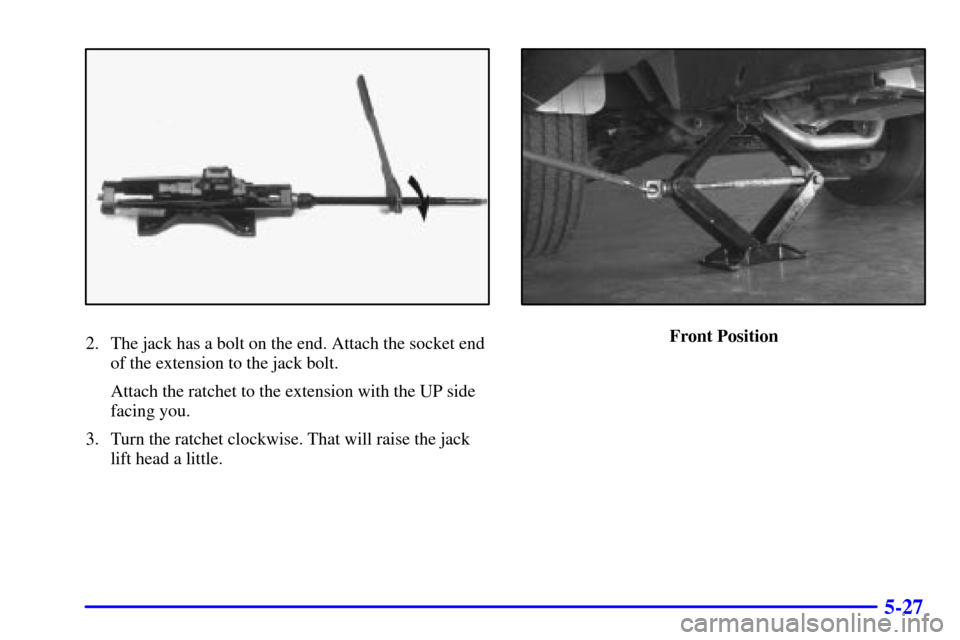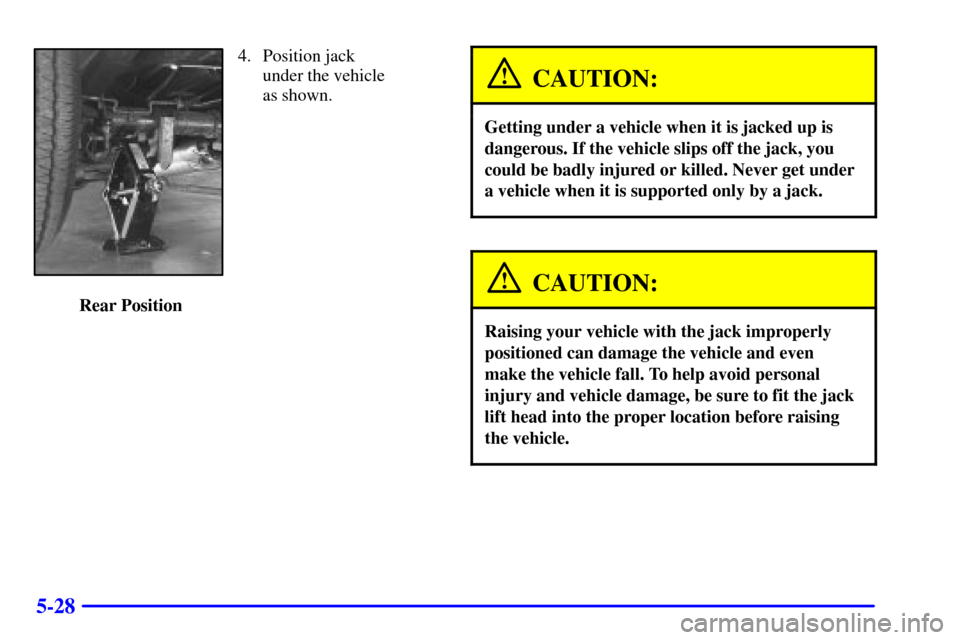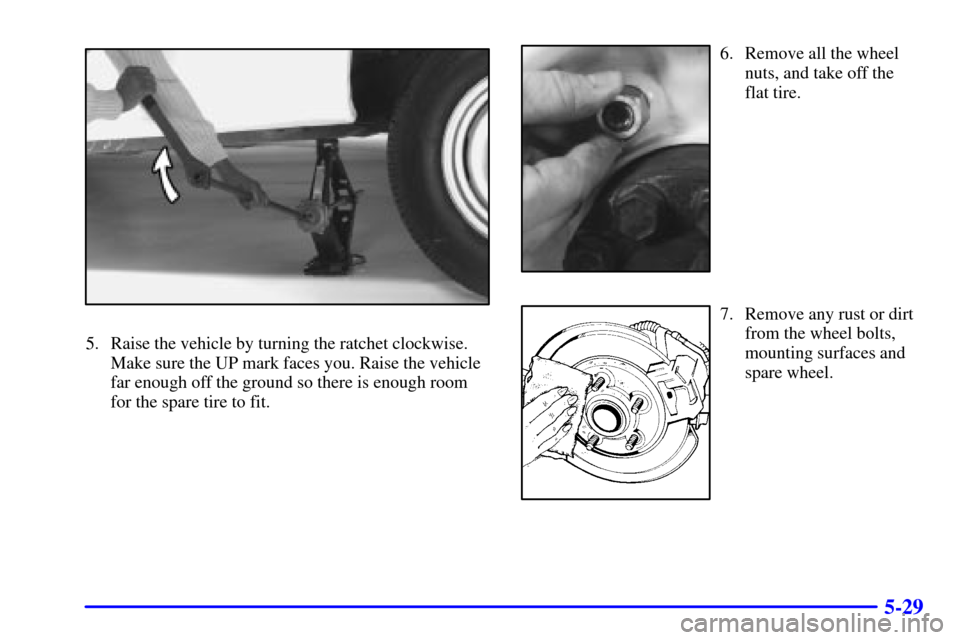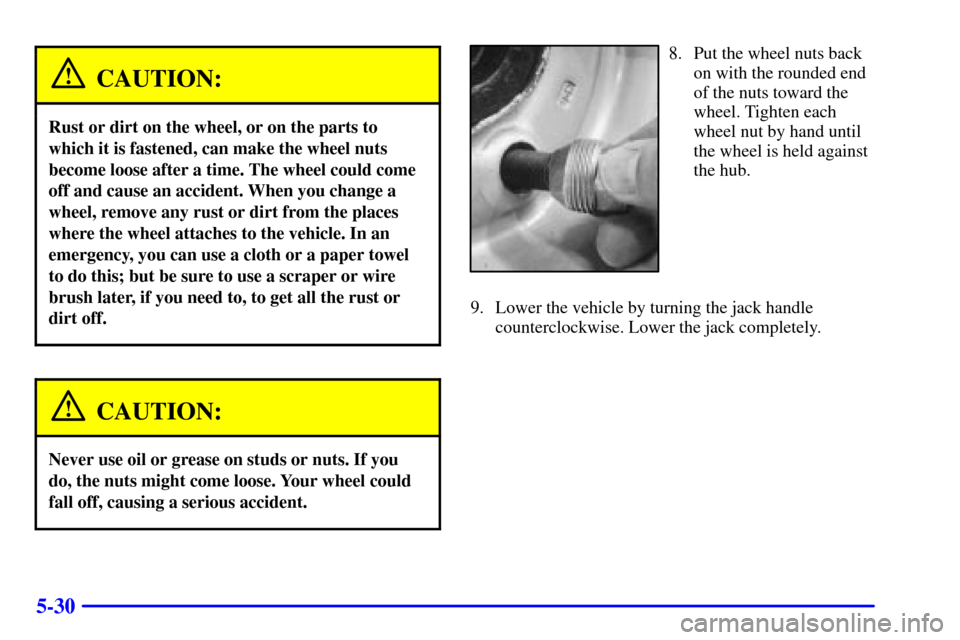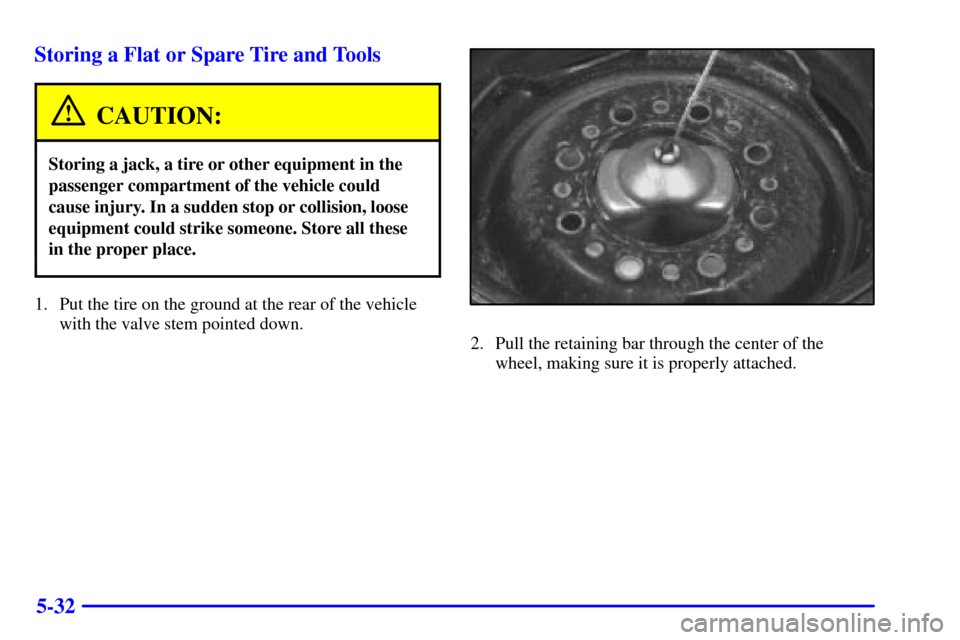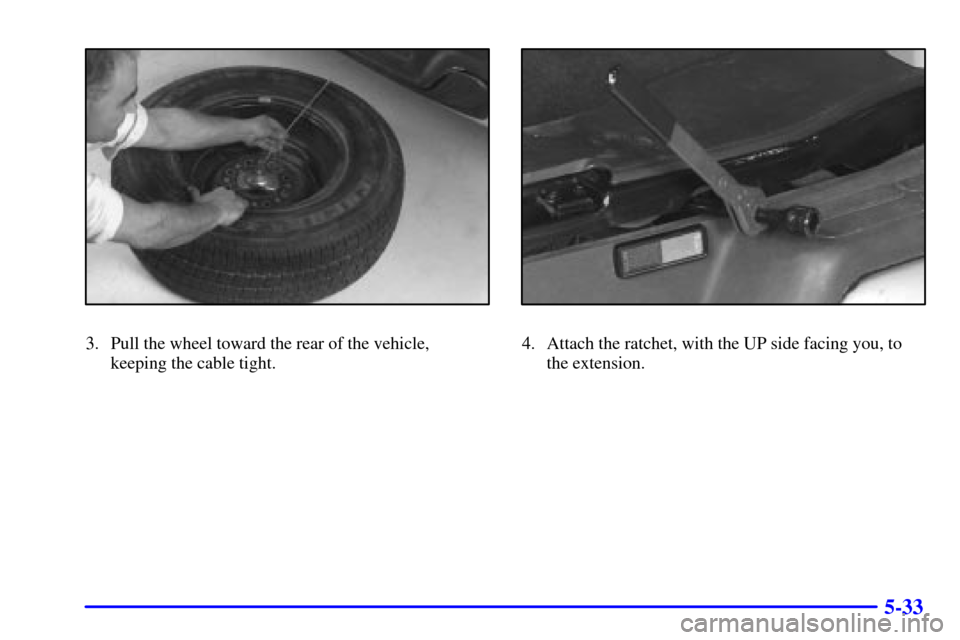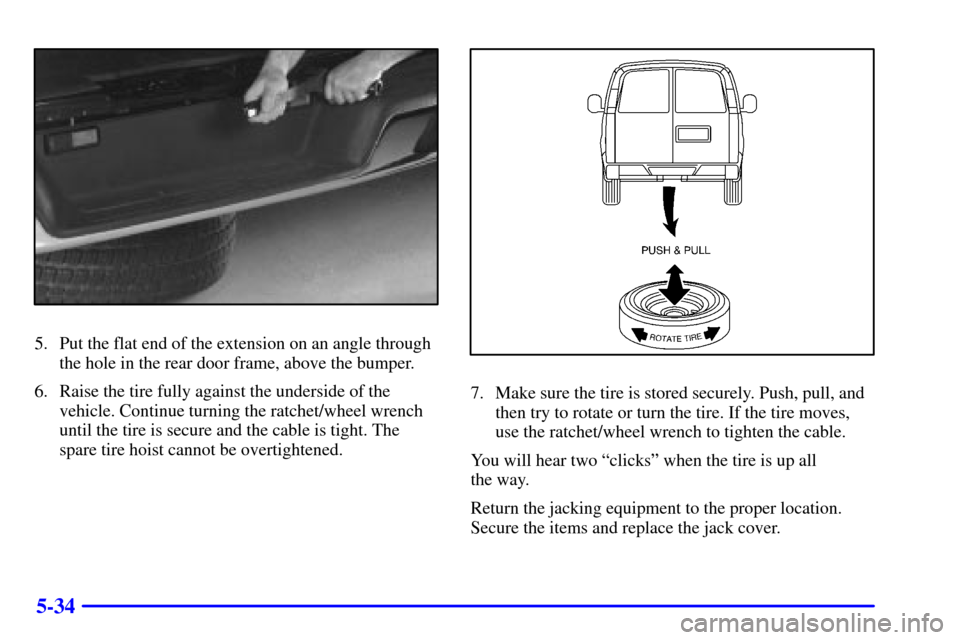CHEVROLET EXPRESS CARGO VAN 2001 1.G Owners Manual
EXPRESS CARGO VAN 2001 1.G
CHEVROLET
CHEVROLET
https://www.carmanualsonline.info/img/24/8177/w960_8177-0.png
CHEVROLET EXPRESS CARGO VAN 2001 1.G Owners Manual
Trending: fuel, load capacity, turn signal, coolant, belt, height, engine
Page 261 of 412
5-27
2. The jack has a bolt on the end. Attach the socket end
of the extension to the jack bolt.
Attach the ratchet to the extension with the UP side
facing you.
3. Turn the ratchet clockwise. That will raise the jack
lift head a little.Front Position
Page 262 of 412
5-28
4. Position jack
under the vehicle
as shown.
Rear Position
CAUTION:
Getting under a vehicle when it is jacked up is
dangerous. If the vehicle slips off the jack, you
could be badly injured or killed. Never get under
a vehicle when it is supported only by a jack.
CAUTION:
Raising your vehicle with the jack improperly
positioned can damage the vehicle and even
make the vehicle fall. To help avoid personal
injury and vehicle damage, be sure to fit the jack
lift head into the proper location before raising
the vehicle.
Page 263 of 412
5-29
5. Raise the vehicle by turning the ratchet clockwise.
Make sure the UP mark faces you. Raise the vehicle
far enough off the ground so there is enough room
for the spare tire to fit.
6. Remove all the wheel
nuts, and take off the
flat tire.
7. Remove any rust or dirt
from the wheel bolts,
mounting surfaces and
spare wheel.
Page 264 of 412
5-30
CAUTION:
Rust or dirt on the wheel, or on the parts to
which it is fastened, can make the wheel nuts
become loose after a time. The wheel could come
off and cause an accident. When you change a
wheel, remove any rust or dirt from the places
where the wheel attaches to the vehicle. In an
emergency, you can use a cloth or a paper towel
to do this; but be sure to use a scraper or wire
brush later, if you need to, to get all the rust or
dirt off.
CAUTION:
Never use oil or grease on studs or nuts. If you
do, the nuts might come loose. Your wheel could
fall off, causing a serious accident.
8. Put the wheel nuts back
on with the rounded end
of the nuts toward the
wheel. Tighten each
wheel nut by hand until
the wheel is held against
the hub.
9. Lower the vehicle by turning the jack handle
counterclockwise. Lower the jack completely.
Page 265 of 412
5-31
10. Tighten the
nuts firmly in
a crisscross
sequence as
shown. Turn
the wheel
wrench clockwise.
CAUTION:
Incorrect wheel nuts or improperly tightened
wheel nuts can cause the wheel to become loose
and even come off. This could lead to an accident.
Be sure to use the correct wheel nuts. If you have
to replace them, be sure to get new GM original
equipment wheel nuts.
Stop somewhere as soon as you can and have
the nuts tightened with a torque wrench to
140 lb
-ft (190 N´m).
NOTICE:
Improperly tightened wheel nuts can lead to
brake pulsation and rotor damage. To avoid
expensive brake repairs, evenly tighten the wheel
nuts in the proper sequence and to the proper
torque specification.
11. Put the wheel cover back on, or put the center cap
and plastic wheel nut caps back on. Remove any
wheel blocks.
Remember that the jack, jacking equipment and tire
must be properly stored in their original storage
position before you begin driving again. The next
part will show you how.
Page 266 of 412
5-32 Storing a Flat or Spare Tire and Tools
CAUTION:
Storing a jack, a tire or other equipment in the
passenger compartment of the vehicle could
cause injury. In a sudden stop or collision, loose
equipment could strike someone. Store all these
in the proper place.
1. Put the tire on the ground at the rear of the vehicle
with the valve stem pointed down.
2. Pull the retaining bar through the center of the
wheel, making sure it is properly attached.
Page 267 of 412
5-33
3. Pull the wheel toward the rear of the vehicle,
keeping the cable tight.4. Attach the ratchet, with the UP side facing you, to
the extension.
Page 268 of 412
5-34
5. Put the flat end of the extension on an angle through
the hole in the rear door frame, above the bumper.
6. Raise the tire fully against the underside of the
vehicle. Continue turning the ratchet/wheel wrench
until the tire is secure and the cable is tight. The
spare tire hoist cannot be overtightened.
7. Make sure the tire is stored securely. Push, pull, and
then try to rotate or turn the tire. If the tire moves,
use the ratchet/wheel wrench to tighten the cable.
You will hear two ªclicksº when the tire is up all
the way.
Return the jacking equipment to the proper location.
Secure the items and replace the jack cover.
Page 269 of 412
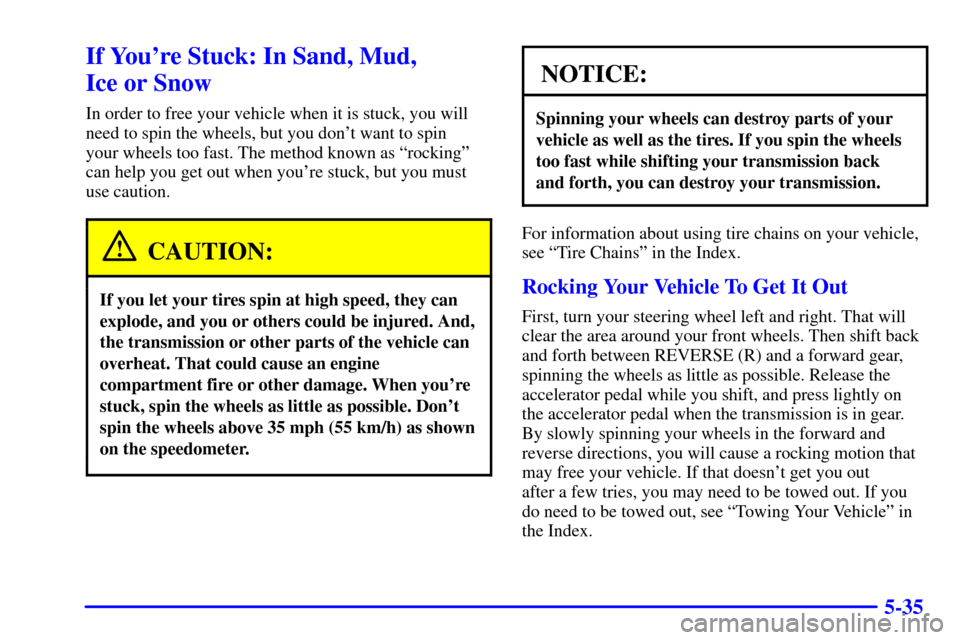
5-35
If You're Stuck: In Sand, Mud,
Ice or Snow
In order to free your vehicle when it is stuck, you will
need to spin the wheels, but you don't want to spin
your wheels too fast. The method known as ªrockingº
can help you get out when you're stuck, but you must
use caution.
CAUTION:
If you let your tires spin at high speed, they can
explode, and you or others could be injured. And,
the transmission or other parts of the vehicle can
overheat. That could cause an engine
compartment fire or other damage. When you're
stuck, spin the wheels as little as possible. Don't
spin the wheels above 35 mph (55 km/h) as shown
on the speedometer.
NOTICE:
Spinning your wheels can destroy parts of your
vehicle as well as the tires. If you spin the wheels
too fast while shifting your transmission back
and forth, you can destroy your transmission.
For information about using tire chains on your vehicle,
see ªTire Chainsº in the Index.
Rocking Your Vehicle To Get It Out
First, turn your steering wheel left and right. That will
clear the area around your front wheels. Then shift back
and forth between REVERSE (R) and a forward gear,
spinning the wheels as little as possible. Release the
accelerator pedal while you shift, and press lightly on
the accelerator pedal when the transmission is in gear.
By slowly spinning your wheels in the forward and
reverse directions, you will cause a rocking motion that
may free your vehicle. If that doesn't get you out
after a few tries, you may need to be towed out. If you
do need to be towed out, see ªTowing Your Vehicleº in
the Index.
Page 270 of 412
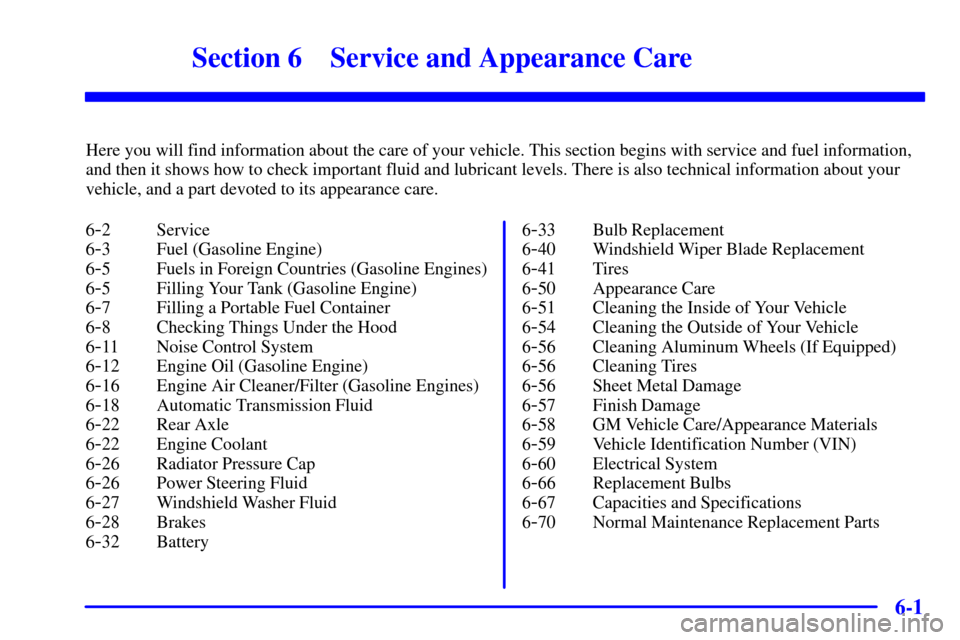
6-
6-1
Section 6 Service and Appearance Care
Here you will find information about the care of your vehicle. This section begins with service and fuel information,
and then it shows how to check important fluid and lubricant levels. There is also technical information about your
vehicle, and a part devoted to its appearance care.
6
-2 Service
6
-3 Fuel (Gasoline Engine)
6
-5 Fuels in Foreign Countries (Gasoline Engines)
6
-5 Filling Your Tank (Gasoline Engine)
6
-7 Filling a Portable Fuel Container
6
-8 Checking Things Under the Hood
6
-11 Noise Control System
6
-12 Engine Oil (Gasoline Engine)
6
-16 Engine Air Cleaner/Filter (Gasoline Engines)
6
-18 Automatic Transmission Fluid
6
-22 Rear Axle
6
-22 Engine Coolant
6
-26 Radiator Pressure Cap
6
-26 Power Steering Fluid
6
-27 Windshield Washer Fluid
6
-28 Brakes
6
-32 Battery6
-33 Bulb Replacement
6
-40 Windshield Wiper Blade Replacement
6
-41 Tires
6
-50 Appearance Care
6
-51 Cleaning the Inside of Your Vehicle
6
-54 Cleaning the Outside of Your Vehicle
6
-56 Cleaning Aluminum Wheels (If Equipped)
6
-56 Cleaning Tires
6
-56 Sheet Metal Damage
6
-57 Finish Damage
6
-58 GM Vehicle Care/Appearance Materials
6
-59 Vehicle Identification Number (VIN)
6
-60 Electrical System
6
-66 Replacement Bulbs
6
-67 Capacities and Specifications
6
-70 Normal Maintenance Replacement Parts
Trending: night vision, clock, air suspension, buttons, mileage, fuse box, inflation pressure
